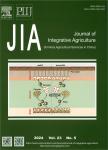Weakened carbon and nitrogen metabolisms under post-silking heat stress reduce the yield and dry matter accumulation in waxy maize
Weakened carbon and nitrogen metabolisms under post-silking heat stress reduce the yield and dry matter accumulation in waxy maize作者机构:Jiangsu Key Laboratory of Crop Genetics and Physiology/Jiangsu Key Laboratory of Crop Cultivation and Physiology/Agricultural CollegeYangzhou UniversityYangzhou 225009P.R.China Jiangsu Co-Innovation Center for Modern Production Technology of Grain CropsYangzhou UniversityYangzhou 225009P.R.China Joint International Research Laboratory of Agriculture and Agri-Product Safety of the Ministry of EducationYangzhou UniversityYangzhou 225009P.R.China
出 版 物:《Journal of Integrative Agriculture》 (农业科学学报(英文版))
年 卷 期:2020年第19卷第1期
页 面:78-88页
核心收录:
学科分类:0710[理学-生物学] 0832[工学-食品科学与工程(可授工学、农学学位)] 0830[工学-环境科学与工程(可授工学、理学、农学学位)] 1004[医学-公共卫生与预防医学(可授医学、理学学位)] 0905[农学-畜牧学] 0906[农学-兽医学] 09[农学] 0901[农学-作物学] 0703[理学-化学] 0902[农学-园艺学] 0713[理学-生态学]
基 金:supported by the National Key Research and Development Program of China (2016YFD0300109 and 2018YFD0200703) the National Natural Science Foundation of China (31771709 and 31471436) the Priority Academic Program Development of Jiangsu Higher Education Institutions, China
主 题:waxy maize heat stress nitrogen metabolism photosynthetic enzymes senescence dry matter
摘 要:Post-silking high temperature is one of the abiotic factors that affects waxy maize(Zea mays L. sinensis Kulesh) growth in southern China. We conducted a pot trial in 2016–2017 to study the effects of post-silking daytime heat stress(35°C) on the activities of enzymes involved in leaf carbon and nitrogen metabolisms and leaf reactive oxygen species(ROS) and water contents. This study could improve our understanding on dry matter accumulation and translocation and grain yield production. Results indicated that decreased grain number and weight under heat stress led to yield loss, which decreased by 20.8 and 20.0% in 2016 and 2017, respectively. High temperature reduced post-silking dry matter accumulation(16.1 and 29.5% in 2016 and 2017, respectively) and promoted translocation of pre-silking photoassimilates stored in vegetative organs, especially in leaf. The lower leaf water content and chlorophyll SPAD value, and higher ROS(H2O2 and O2^-·) content under heat stress conditions indicated accelerated senescent rate. The weak activities of phosphoenolpyruvate carboxylase(PEPCase), Ribulose-1,5-bisphosphate carboxylase(Ru BPCase), nitrate reductase(NR), and glutamine synthase(GS) indicated that leaf carbon and nitrogen metabolisms were suppressed when the plants suffered from a high temperature during grain filling. Correlation analysis results indicated that the reduced grain yield was mainly caused by the decreased leaf water content, weakened NR activity, and increased H2O2 content. The increased accumulation of grain weight and post-silking dry matter and the reduced translocation amount in leaf was mainly due to the increased chlorophyll SPAD value and NR activity. Reduced PEPCase and Ru BPCase activities did not affect dry matter accumulation and translocation and grain yield. In conclusion, post-silking heat stress down-regulated the leaf NR and GS activities, increased the leafwater loss rate, increased ROS generation, and induced pre-silking carbohydrate tran



